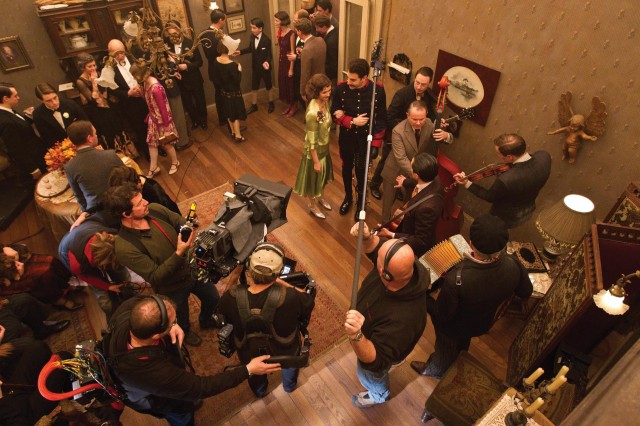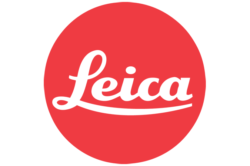In the current February issue of Film and Digital Times, we interviewed Larry McConkey about his Steadicam work on Martin Scorcese’s Hugo.
Jon Fauer: When did you start on Hugo?
Larry McConkey: I got a phone call at about 4 in the morning in late April, 2010. A voice said, “Larry, you have to get on a plane.” “Who is this?” I asked. “You have to be at the airport in like an hour and a half, so get going” was the reply. I recognized the voice—it was Bob Richardson calling about a 3D film with Martin Scorcese. I immediately flew out to LA and started working with the great team at Cameron|Pace.
That trip was critical, both in helping design a 3D rig that was practical—light enough, small enough and self-balancing—but also in redesigning my Steadicam to handle the weight and power requirements of the 3D rig with two Alexas. I was determined not to let my operating be compromised by the equipment. Cameron|Pace was really responsive and did a brilliant job, and I went to work on my own gear. I’ve flown several IMAX cameras, but this was heavier. It was so heavy that my Steadicam arm was bending sideways from the load. I took power connectors and threw away the metal casings and potted them in epoxy to make them lighter, bought new lightweight monitors and video recorders, re-wired the sled and added additional battery mounts and a hundred other little mods. Finally, Gregor put together a set of the Cooke Panchro/i primes for me that matched our S4/i and 5/i lenses very well and were much lighter. That made a real difference.
Tell us more about the Segway.
The crane on the electric camera car with the stabilized head at the front was a scary-looking machine. It took a lot of time to safely get a shot up to speed. I was looking for a way to move my much smaller rig quickly through the set, without running—that just wasn’t going to happen with this beast. I called Chris Fawcett, a Steadicam Operator in Holland. Chris brought his Handsfree Transporter 2, a Segway modified for Steadicam use, and taught me how to ride it. We then made some modifications: a seat to allow a very low operating position, fenders to protect the 3D rig (courtesy of the extremely skillful special effects department), and mounting for video transmitter, batteries and my gyro kit. Chris now offers his own modified version of a Segway, the Steadiseg, based partly on those mods.
When it came time to do a POV of the dog racing through the station, I told Bob I could do it. Could I? This was a big movie, and the rig was very heavy and I was inexperienced with the Segway… should I really be trying this? I took a deep breath and went for it. Marty was at the other end of the stage. After several rehearsals, building up speed with each one, I did the first take, and I immediately heard yelling. “What’s that?” I asked Bob, as he met me returning from the run.
“I guess it’s not working out”, he said, “Marty’s not happy”.
I was crestfallen. Then a moment later: “Just kidding—he loved it!” Marty was excited to shoot so quickly and easily. Up to then camera car shots through crowds with the 3D rigs had been an exercise in extreme patience.
What was your most challenging Steadicam shot in the movie?
It was definitely the end sequence, in Méliès’ apartment. In most of the films I’ve worked on with Martin Scorsese, there’s been at least one sort of signature long Steadicam shot.
You did the Ray Liotta Copacabana shot in Goodfellas?
Yes. But this time the camera was much heavier and bulkier, making it harder to maneuver, and 3D brings its own unique problems as well. I was definitely feeling the pressure and the weight.
Take us through the end shot.
Bob wisely let me know well ahead of time that I would do the shot, so I had time to prepare. For a long shot to succeed, every idea has to lead seamlessly to the next one, every moment needs to have meaning, and every detail has be nailed down. I have learned to take responsibility for everything, rehearsing all the critical parts endlessly. This shot required even more.
Marty wanted me to meet George coming down the hallway and follow him into the party, and I thought, why not start outside the building and fly through the window—evoking that amazing opening sequence? The set was a couple of stories above the floor of the studio, so scaffolding was needed for the track (I rode a dolly, then stepped off into the hallway. The window was added later by visual effects). All of the main characters were at the party and Marty wanted to see each of them.
It was complicated by one other specific request: near the end of the scene, as Chloe sat down in the far corner of the room, Marty asked me to circle all the way around her as she began writing in her notebook—writing the story we have just seen. This required one additional film magic trick.
Special effects built a large dolly and attached it to the far side of the first wall so it could be flown out of my way. The second wall was an outside wall, and the estimate for the additional scaffolding and rigging was $20,000 dollars. Production strongly suggested that I find another solution. The special effects team built a very low profile dolly for the chair, with rails that were sunk into the floor. After the first wall was pulled, Chloe’s chair began to slide away from the corner. I slowed my circular track but continued the pan until I had room to move around her. It had to be a perfectly smooth slide and perfectly timed for the cheat to work. I asked for a witness camera in the corner above the set for cueing and we put several hundred pounds of weight on a sled dolly 2 floors below, connected by steel cables to the sliding chair. My excellent dolly grip, Keith Mead, did that job.
In addition, a bureau was in my way, and then there was the table, right in the center of the room. I could have removed it, but I loved the look of that small room packed full of people and furniture. Crew members doubled up as extras in the party. Two of them picked up the table after I entered the room and danced it around just out of shot, and another pulled the bureau out of my way. Finally, the chandelier was rigged to fly up as we crossed underneath. I wanted it to look so crowded it would be impossible for a camera to get through, and make it look effortless, nonetheless.
I also liked the idea of making a complete circuit of the room, but half way around I had already seen almost everyone. I needed to fill out the second half of the circle with meaningful action. I brought the band in and worked with Sacha the way I had worked with Ray Liotta in the Copacabana. He improvised a brilliant little scene with them as he guided his new girlfriend back towards the doorway, leading me to discover Asa, and then, off his look, I panned to Chloe.
The other dance in the scene was between Demetri, Gregor and me. The dance of 3-D. Every part of this complex shot required Demetri to make adjustments and I had to take each of those into account as the rig reacted. I modified my moves for him and he worked on merging his changes in IO and convergence with my moves. Gregor’s focus pulls had to be accommodated as well. We were interacting with each other throughout.
Working in the new and different environment of 3D was a challenge, but having such a great crew to work with, while telling such a wonderful story, so beautifully shot by Bob Richardson, and led by the great Martin Scorsese, made Hugo the most satisfying job of my career.
photo above: by Jaap Buitendijk © 2011 GK Films, LLC. From Paramount Pictures and GK Films.









